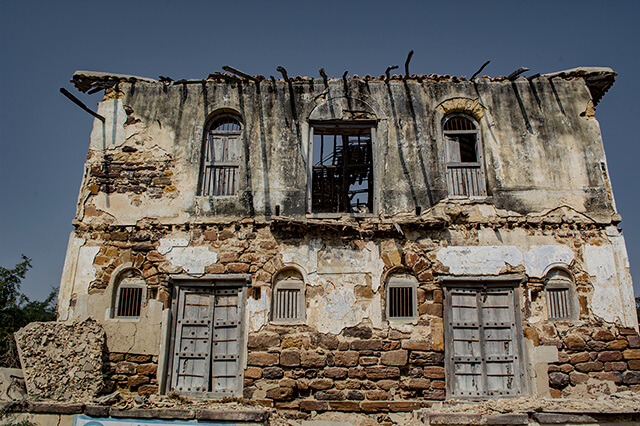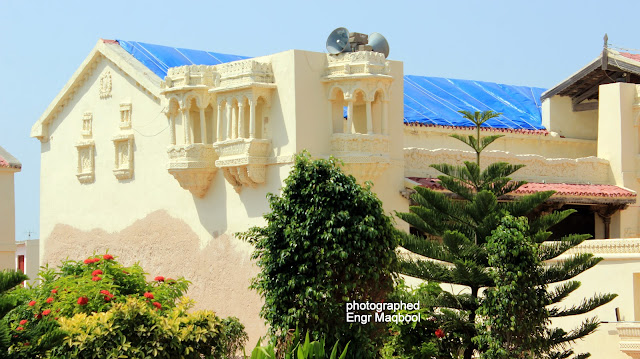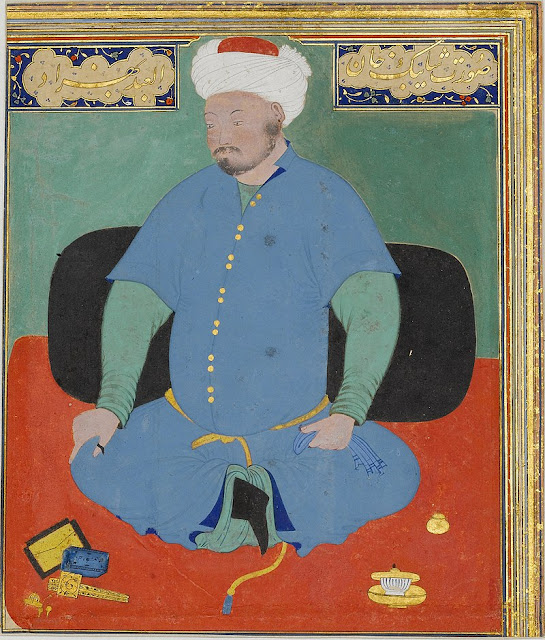Fort
Lakhpat is situated at the mouth of the Kori creek, overlooking the Great Rann
of Kutch, at a distance of 160 Km from Bhuj in State of Gujrat.
Legend has it that the first Guru of
the Sikhs, Guru Nanak Dev Ji, made his final stop at Lakhpat before leaving for
Mecca. The Sufi mystic Pir Ghaus Muhammad was buried in Lakhpat, and his stone
tomb has a water tank which has healing properties.
The
town enclosed by 7 km fort walls which were built in the early 19th century by Jamadar
Fateh Muhammed. The Rann can be seen from the top of the fort. Lakhpat
prospered as a trade route in the Western end of Gujarat.
In the year 1819, an earthquake had hit the town. The Indus
River flowing through Lakhpat changed its course following the earthquake, and
consequently it affected the day to day life of the natives, thus forcing them
to abandon the town. The ones that are still residing in the town are
struggling to lead a comfortable life.
It
is said that the town of Lakhpat used to be home to several millionaires, and
that’s how it got its name from the Hindi word Lakhpati which means
millionaire.
Apparently, the robbers posed a serious
threat to the prosperous town which became a very serious issue for the locals.
One of the administrative heads of that time, Fateh Muhammad, proposed to king
of Lakhpat an idea to construct a protective wall around Lakhpat to ward off
the robbers. However, the king rejected the proposal as there was a scarcity of
funds to commission the construction.
My Travelogue of Fort Lakhpat
the Ghost Town
Today
this Ghost town “Kot Lakhpat” tells story of its grandeur by the ruins in the
shape of the fort walls. Most of the Lakhpat fort town is comprised of
abandoned houses and thus it can be scary and unsafe at night in the region.
It
was an exciting experience to drive towards the extreme north-west part of the
country the last village in that direction. The deserted straight road passes
through never-ending barren land devoid of habitation.
Before
a long 135 Km, from Bhuj in Gujrat to “Kot Lakhpat”, we decided to have
breakfast. From a road side traditional street vendor’s food thela, a quick
desi naashta of Aalu and Pyaz Pakoras, soft Dhoklas, Aalu Banda with chatni,
sweet and hot Jalebis with a garam chai, was a start to wander in history.
We were entering just as Camel caravans once did centuries ago,
laden with goods destined to be shipped from the Lakhpat port to far corners of
the Indian Ocean. This entrance gate in the southern portion of the fort wall
on the road from Bhuj was open with a gate on the road just inside the walls.
Four
other gates service the town along with pedestrian Bari, a "window".
Here, a toll booth stood ready to collect tolls and customs from visitors and
traders before they were allowed access to the rest of the town. Bhungas housed
Arab guards nearby, who were employed by the town for protection.
“Tropic of Cancer is passing from here”
About
40-45 kilometers prior to Lakhpat, another sensational surprise was waiting to
accrue the thrill of our journey. A large board on our left was displaying,
“Tropic of Cancer is passing from here” and I immediately stopped and stepped
out to capture the moment in my camera.
A
few steps from the display board were a white line drawn on the road to
indicate the probable imaginary line. Unbelievable, am I really witnessing the
imaginary line, about which we have read only in our geography books during
school days!
Hereafter,
we didn’t find a single vehicle or any habitat on the way except occasional
sighting of monitor lizards and mongoose shying away into the bushes, until
hitting the dead end at the ruined magnificent fort.
Looked out through the window of Taxi:
all was barren wilderness and a straight road passing through the middle of it.
And finally reached at
“Ghost Town Lakhpat”
The place of my dreams, since I have seen
Hindi movie “Refujee”, of Abhishek Bachhcan and Kareena Kapoor, shot in
Lakhpat. The deserted straight road passes through never-ending barren land
devoid of habitation.Trust me, if you don’t get yourself a car or a taxi,
you’ll be a sitting duck under the scorching sun.
In one of India's
remote corners (Bhuj, state of Gujrat) on India-Pakistan border lays a deserted
village of hardly a few hundred populations within a sprawling fortification.
The
village is no other than Lakhpat, once a thriving port with daily revenue
believed to exceed one hundred thousand (one lakh) koris. Hence its name is
Lakhpat.
The straight road ended at the fort gate. There was nobody
around. The car drived past the fort’s entrance gate that opened out to a vast
barren expanse with a few abandoned shacks. Inside too, not a single soul in
sight.
History of Ghost Town
Lakhpat
As I
approach the now deserted ghost town Lakhpat, a hushed breeze redolent with
countless stories—some fact, some legend—sweeps over the crumbling ruins.
The
literal meaning of Lakhpat is the city of millionaire as historically town was
bustling with port activities and had daily revenue of one lakh Kori, the
former currency.
Lakhpat was founded by Rao Lakhpatji
(1752-61) the ruler of the State of Kutch. The settlement was later fortified
in 1801 by Jamadar Fateh Muhammed, a Kutch General, to defend the kingdom from
the Sindhis across the river.
The 7 kilometer long fortification, much of
which still stands, was at one time manned by 50 Arabs and 150 Kutch soldiers.
Within it was a populace of millionaire merchants, predominantly Muslim, with a
spattering of Hindus, trading in opium, rice, ghee, silk and perfumes with
Sindh.
How Lakhpat: A port and fertile land, was abandoned and
turned as a Ghost town.
And then, when it was merely
half a century old, an earthquake with an estimated magnitude of 7.7 to 8.2
occurred on the evening of 16 June, 1819. And everything changed.
This
earthquake changed the course of the Indus River on whose banks the town had
been built, moving it 150 kilometers away.
Lakhpat’s riches, as both a port and
fertile land, declined almost overnight. The town was abandoned to be replaced
with thorny acacia trees and dusty desert sands. Where formerly over 10,000
inhabitants had lived in luxury within the fortified walls, the number dropped
over the following centuries to a few hundred struggling to subsis
Today
it is ghost town, a city of ruins of buildings and a magnificent fort
surrounding them. The population was 463 in 87 households 2001 which increased to
566 in 108 households in 2011.
What I Saw Inside
Ghost Town Lakhpat
The straight road ends at
the fort. There is nobody around. The car drives past the fort’s entrance gate
that opens out to a vast barren expanse with a few abandoned shacks. Inside too,
not a single soul in sight. It was about 12.30 P.M, Sun was just over our heads
in sky.
A small tea stall was
located at the corner of the main entrance-- It seemed unbelievable, that we
had reached the extremely distant part of the land. The display boards at the
entry points were boasting about the glorious past of Lakhpat, now a protected
place. Looking around, we didn’t find anybody.
Our
car entered inside the gate. Here I clicked some memorable shots. Taxi driver
was telling us about the glorious past of this place, while driving inside on
soily lanes. The silent inhibited buildings were mook evidence of their rich
past.
Inside fort we
saw a broken Custom House, which was the chief administrative office for trade
in the mid 19th century. It was known as the Chowk Bazaar. Just close to it is
Akbani Mahal, which was home to an affluent trading family of Lakhpat.
The
Akbanis are Muslims of the Memon community and also are well known to this day
for their far reaching trading empire, mostly centered now in Bombay.
Taxi
driver stopped Innova car at a place. Being a local man he was well informed
about the history and local folk tales of this place. He told: This is Pir
Ghaus Muhammad tomb.
He was a Sufi saint of Lakhpat, was believed to have supernatural
powers. After Pir’s death in 1855, his brother Shah Saheb began to build a tomb
locally known as Kubo. Pir's body rests here along with other members of his
family.
This tomb is constructed
over a palatiform by black stones, octagonal in shape, with four side doors
arched and richly carved. The walls are decorated with patterns of flowers and
leaves. The grave inside tomb is covered with a white marble canopy.
Opposite
the tomb is a water tank which is believed to have healing characteristics for
skin diseases. Ravi told that water of these tanks changes its color by every
day of week
In
one corner of this water tank, was stone stairs leading to fort wall top. I
couldn’t stop my curiosity to climb over the stairs. Climbing up a few stairs
over the Fort wall, we could see 360 degree views of Kori Creek, Marsh land,
Sand and Rann of Kachh.
Further
ahead is said to be Pakistan: As we couldn’t see any establishment on the end
of our vision, we exactly do not know where it was.
So yes, Lakhpat is a place where once upon a time people resided. It’s
a place where Muslim masjid and tombs exist alongside the temples and the
Gurudwaras.
Langar at Lakhpat
Gurudwara Sahib
It
was around 1.45 P.M, when driver stopped at door of Gurudawara. A Sikh Gyani (priest)
welcomed, and asked for Langer. After the darshan. The Langar had daal, roti,
rice and halwa. All cooked in pure ghee. we had langar with home type cooked
prasad and food. Free langar and tea are served to the visitor around the
clock.
You
need to wash your own utensils at Gurudwara.The langar had daal, roti, rice and
halwa. The food tasted good.
I
especially loved the halwa made with desi ghee. Few Sikhs who run the place
were extremely helpful and smiling, willing to answer many of my questions. You
needs to cover your head if you wish to enter the prayer room at a gurudwara.
Somewhere ahead, there is an old Shiva temple too.
History of Gurudawara
at Lakhpat: Gurdwara Pehli Patshahi
Gurdwara
Pehli Patshahi meaning the "Gurdwara of the first master" is situated
at Lakhpat. Guru Nanak Devji Sahib stayed here 40 days during his second and
fourth missionary journeys to holy places of Islam, Mecca and Madina, in
1506-1513 AD and 1519-1521 AD respectively.
Gurdwara Guru Nanak Sahib
has been built to preserve the memory of these visits of Guru during the early
1500s. A few rare personal possessions of his are retained here.
Several
rare treasure are preserved in this Gurudawara. It includes the “Charan
Paduka”-Khadvas (wooden footwear) of Guru Nanak Devji’s. It houses relics such
as decorative carved wooden cradle.
We
saluted these real life heroes. The real job is done by those who put their
lives in danger every single day on their job. The BSF jawans overlook the Rann
and the Pakistan border straight, with the air distance not being more than 20
kms.
They
protect our borders in all conditions, from cold to dry and hot conditions of
the Rann. Realized degree of difficulties of this border place “The Lakhpat”,
where even water is scarce and ration of vegetables are limited.
Coming out of the nostalgic tranquility of the fortified ancient
ruined settlement. No basic infrastructure, no petrol pumps, no accommodation
facilities around hundreds of miles and not even a public transport beyond
Dayapar. Totally discriminated, ignored, neglected, isolated and disconnected
place. Is it due to infiltration prone
zone!
Here I spent most memorable
few hours of my life and clicked few most beautiful clicks from camera.
Most of the Lakhpat fort town is comprised
of abandoned houses and thus it can be scary and unsafe at night in the region.
It is advised to take shelter in the Gurudwara as the management there is very
hospitable towards travelers.
The
End





.jpg)














